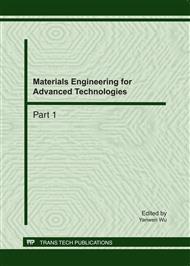p.238
p.242
p.246
p.250
p.256
p.261
p.266
p.272
p.278
Determination of Bioactive Components of Oil-Tea Cake by Pyrolysis- GC/MS
Abstract:
The oil-tea cake is the particular byproduct during producing tea-oil from seeds of Camellia oleifera (oil-tea tree). However, the current processing and utilization of oil-tea cake is still low economic benefit and also low value-added. Therefore, 300°C-based pyrolysis- GC/MS technology was used to analyze the top value-added bioactive components of benzene/ethanol extractives of oil-tea cake. The analytical result showed that 14 peaks were obtained from the 300°C pyrolyzate of benzene/ethanol extract of oil-tea cake, and 13 compounds representing 99.16% of the total areas were identified. The MS analytical result showed that the main components of pyrolyzates of benzene/ethanol extractives of oil-tea cake by 300°C pyrolysis- GC/MS were identified as: ethyl oleate; 14-pentadecenoic acid; pentadecanoic acid, ethyl ester; hexadecanoic acid, 2-hydrsoxy-1,3-propanedryl ester; pentadecanoic acid, ethyl ester; squalene; 1,2-benzenedicarboxylic acid, butyl 2-methylpropyl ester; 1,2-benzenedicarboxylic acid, 3-nitro-; etc.The results of function analyses showed that the 300°C pyrolyzate of benzene/ethanol extractives of oil-tea cake contains abundant bioactive components of rare natural medicinal materials, and also contain many components which can be developed into two value-added materials of industrial chemical and high-grade spice.
Info:
Periodical:
Pages:
256-260
Citation:
Online since:
June 2011
Authors:
Price:
Сopyright:
© 2011 Trans Tech Publications Ltd. All Rights Reserved
Share:
Citation:


